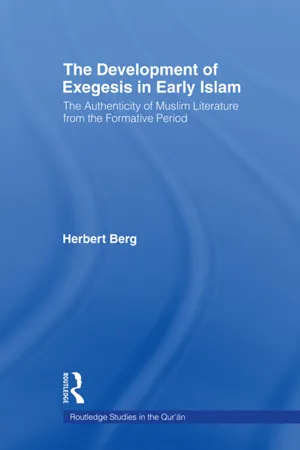![]()
Chapter 1
Introduction
The study of Islamic origins, whether focussing on the Qurɔān, its exegesis (tafsīr), the life of the Prophet (sīra), jurisprudence (fiqh), or even Arabic grammar (nacw), has been largely confounded by a growing scepticism. While many scholars of Islam still have no qualms about the authenticity of purportedly early Islamic texts, many others have serious reservations. At the crux of this debate is the value scholars assign to the chain of transmitters (the isnād), which is intended to demonstrate the authenticity and indicate the provenance of the tradition (ḥadīth) or book of which it is a part. The isnād is seen either as reasonably reliable guarantee of the historicity of its adjoining text (the matn), or as a complete fabrication designed to insinuate chronological priority and hence authority into a later matn.1 Scholars holding the latter view look, not to the isnād, but often to the matn itself to provide answers to the questions of its own chronology and provenance. These two approaches to isnāds are indicative of the approaches to early Islamic texts in general. If the consequences of this disagreement amounted to a simple debate about whether a given ḥadīth or text is authentic, they would not be particularly noteworthy. Unfortunately, the consequences are far more grave. The scholars on each side of the debate have produced descriptions of Islamic origins that are radically different and mutually exclusive. So different are the methods used and the conclusions reached by sceptical scholars from those of more sanguine scholars that they have come to an impasse.
AN EXPERIMENT USING EXEGETICAL ḤADĪTHS
Not surprisingly therefore, the first of two purposes of this study is to help resolve this impasse. To do so I will draw on the methods of both groups of scholars. More specifically, I will determine if there is a correlation between the results of an isnād-analysis and of a literary analysis of matns, in order to evaluate the historical value of isnāds. The initial question to be answered is, of course, where to begin? Isnāds are ubiquitous in the literature of early Islam. ḥadīths, composed of matns and isnāds, are particularly prominent in the legal, historical, and exegetical texts. Exegetical ḥadīths are an especially practical and valuable subset of the ḥadīths with which to delve into the questions of the authenticity of isnāds and, hence, ḥadīths as a whole. Not only has this genre been somewhat neglected, but it also: (1) involves ḥadīths concerned with the most important text of Islam, the Qurɔān; (2) contains a vast number of ḥadīths, many of which have isnāds which cite the important transmitters of the ḥadiths of the other genres; (3) encompasses the historical, and legal genres insofar as they relate to the Qurɔān; and (4) adduces hadīths which initially seem to be immune from the sectarian and legal debates and competition which may have affected the reliability of other ḥadīths. These considerations make exegetical ḥadīths ideal for testing the reliability of the isnād system.
Abū Jacfar Muḥammad ibn Jarīr al-Ṭabarī (d. 311/923) is one of Islam’s most respected early historians and exegetes, and his Jāmic al-bayān fī taɔwīl āy al-Qurɔān, also known as the Tafsīr of al-Ṭabarī, is the first substantial compilation of the opinions of the earliest quranic exegetes. Though the Tafsīr is not exclusively a compilation, it does contain a vast number of exegetical ḥadīths purporting to provide the exegetical opinions of the earliest generations of Muslims, the Companions of the Prophet, their Successors, and the Successors of the Successors. Thus, it may serve as a valuable repository of Muslim thought and practice during Islam’s formative period. This is not to say that I am assuming, like most Muslim scholars and many Western scholars,2 that the Tafsīr contains the authentic words of the earlier exegetes, and most, if not all, of the material available to al-Ṭabarī. Such assumptions may be simply untenable given the doubts raised by John Wansbrough about the authenticity of all early Muslim written sources in general3 and those raised by Ignaz Goldziher and Joseph Schacht about the authenticity of both the isnāds and the matns of the ḥadīth literature in particular.4 Though these doubts were raised with respect to the prophetic ḥadīths of the legal realm, their similarity in form and content with the exegetical ḥadīths suggest the same doubts may apply.5 Consequently, to make such assumptions would be tantamount to assuming what I hope to prove.
Analysizing each of the 38,397 ḥadīths6 (many with multiple isnāds) in the Tafsīr is impractical. Therefore it is necessary to restrict the number of ḥadīths to be examined. There are several ways to do this: random selection of ḥadīths, selecting ḥadīths from several sūras or specific verses, or selecting a particular exegete. While all three methods may, in various ways, be non-representative of the ḥadīths in al-Ṭabarī as a whole, the first two methods are more likely to be so because many isnads are not distributed uniformly over the entire Qurɔān and some are completely absent from large sections in the Tafsīr. However, if an appropriate exegete were chosen, one who appears throughout the Tafsīr and in various different isnāds, this problem could be overcome. Fortunately, the Tafsīr contains an excellent candidate and one who is worthy of study in his own right. He is seen by some scholars of quranic exegesis as the earliest and most respected quranic exegete, one who cannot be gainsaid, and by others as the (fictional or mythic) personification of consensus of the early Sunnī community. In either case, there is no other quranic exegete of his stature. In many ways, he is to exegetical ḥadīths what Muḥammad is to legal ḥadīths. This exegete is, of course, cAbd Allāh ibn cAbbās (d. 67–8/ 686–8), the Prophet’s paternal cousin and ancestor of the cAbbāsid dyna...
